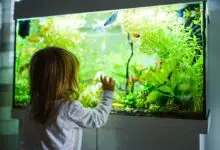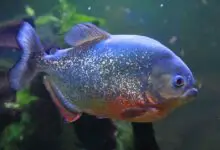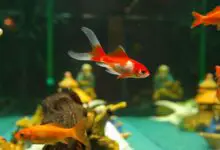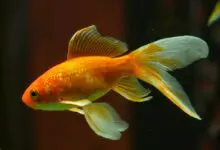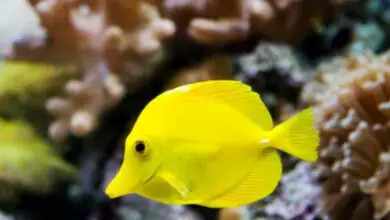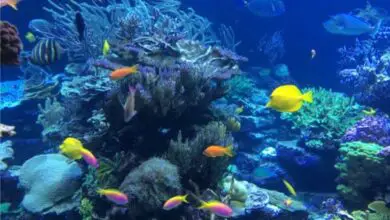Choosing Safe Woods, Plants And Rocks For Healthy Aquariums

Decor transforms bare tanks into lush underwater landscapes. But natural materials like driftwood, live plants and rocks carry risks. Wood can leach tannins. Plants sometimes shed debris. Rocks may alter water chemistry.
With care and research, aquarists can safely incorporate nature’s beauty. This guide covers selecting safe natural decor for freshwater fish tanks. Learn to build eye-catching environments that won’t endanger your aquatic residents.
The Benefits of Natural Materials Over Plastic
Natural driftwood, live plants and rocks have advantages over artificial decor:
- More authentic replication of fish habitats
- Improved water quality from live plants
- Surfaces for beneficial bacterial growth
- Shelter and environmental enrichment
- Natural nutrient cycling in the tank ecosystem
- Visual depth, textures and colors
The main downside is the extra preparation natural materials require:
- Proper selection to avoid toxins
- Sterilizing and cleaning prior to use
- Monitoring parameters and addressing impacts
With some cautions, natural materials enhance tanks as both chemical and biological filters. They sustain mini ecosystems where fish thrive.
Choosing Safe and Suitable Driftwood
Driftwood adds a dramatic focal point with gnarled shapes and depth. Look for properly cured hardwoods that won’t decay or affect water chemistry:
- Mopani wood – a rich brown African hardwood, sold as dense pieces that sink readily. It leaches some tannins which can help recreate blackwater streams.
- Manzanita branches – striking reddish twigs with twisting shapes. Manzanita comes from arid areas and resists rotting. Rinse well to prevent excessive tannin leaching.
- Malaysian driftwood – attractive weathered branches in grey and brown tones. It may float initially requiring soak and sink methods. Leaches fewer tannins than other woods.
- Cholla wood – cactus wood native to the Americas. Its holey, branching structure makes great hideouts. Lightweight segments float until waterlogged.
Avoid soft evergreen woods like pine or cedar. Their oils can be toxic. Stick to seasoned hardwoods sold specifically for aquarium use.
Preparing Driftwood Before Use
Untreated wood can still carry risks like organisms, sap or toxins. Take these steps to make it aquarium-safe:
- Select attractive hardwood pieces and rinse well with clean water to remove dust and debris.
- Boil smaller pieces for 1-2 hours until water runs clear. This kills organisms and leaches excess tannins.
- Soak larger pieces for 1-4 weeks. Change the water whenever it darkens from leaching tannins.
- Test soak water with pH strips to see when pH stabilizes below 7.0. The driftwood is then waterloggged and ready for placement.
- Optionally add beneficial bacteria blend to promote early biofilms before adding to a tank.
With proper preparation, the beauty of natural wood can be safely harnessed. Keep an eye on water parameters for the first few weeks and do extra water changes if tannins or organics cause discoloration or lowered pH.
Beginner Friendly Species of Freshwater Plants
Live plants purify water, provide hiding spots and help complete the ecosystem. They come in all shapes and sizes. Some easy, fast growing starter plants include:
- Anacharis – floating stems with small leaves. Grows rapidly under most light. Helps absorb nitrates.
- Java Fern – hardy fern with broad triangular leaves. Rhizome anchors to decor instead of planting in substrate.
- Cryptocorynes – varied group of rosette plants with ruffled leaves. Tolerate low light and colder temperatures.
- Amazon sword – tall background plant with long, pointed leaves. Grows quickly with root tabs. Helps take up ammonia, nitrates.
- Java moss – fluffy bright green moss that carpets surfaces. Attaches and spreads across driftwood and rocks. Low care and no planting required.
- Duckweed – tiny floating plants that propagate rapidly to form dense mats. Absorbs excess nutrients but must be thinned regularly.
Do research to select plants compatible with your tank conditions. Ask for pest-free tissue cultures to avoid hitchhiker organisms on plants.
Quarantining Locally Found Items
Exercise caution before adding anything from backyard streams or beaches to your tank:
- Soak and observe items fully submerged for 2-4 weeks. This gives time for potential toxins or organisms to manifest.
- Check parameters like ammonia and nitrites which can spike from organics or die-off. Discard items that alter water chemistry.
- Review local water quality reports for possible pollution or organism risks where items were gathered. Avoid areas with agricultural/industrial contamination.
- Clean thoroughly with bleach or other disinfectants after the soak period. Rinse extremely well before adding to a tank.
- Quarantine for 4-8 weeks after introducing to monitor for any issues. Remove immediately if problems occur.
Found materials can safely augment purchased decor. Take precautions to avoid devastating tanks with contaminated additions. When in doubt, stick to sourced materials from trusted aquarium suppliers.
Fish Safe Rocks and How to Clean Them
Rocks make excellent tank decor but some leach minerals or metals that alter water chemistry:
- Granites – igneous rocks with quartz, feldspar and other dense minerals. Generally inert and aquarium safe but test individual samples.
- Slates – metamorphic rocks with smooth, layered appearance. Rinse well and check parameters to verify slate pieces don’t affect pH or hardness.
- Limestones – sedimentary rocks made of calcium carbonate. Avoid using limestone as it dissolves and boosts water hardness and pH.
- Sandstones – compacted sedimentary rocks. Safe for aquarium use if dense and non-friable. Soak and test individual pieces before long term use.
To prepare rock decor:
- Scrub thoroughly with clean water – a wire brush helps remove clinging debris and organisms.
- Bleach soak for 1 hour then rinse and dechlorinate well.
- Soak and test for 4 weeks – monitor for pH/hardness shifts and discard rocks that affect water chemistry.
With substrates, research composition and mineral content specifically recommended for aquarium use. Don’t take chances with rocks gathered outside.
Design Principles When Arranging Driftwood and Rocks
Composing an natural aquascape has basic principles for aesthetics and health:
- Odd numbers – use groupings of 1, 3 or 5 pieces. Avoid symmetry.
- Complimentary colors – match darker purples and browns of wood against gray and beige rocks. Contrast against planted greens.
- Layer heights – combine tall background, midground accent pieces and low foreground items.
- Leave open areas – don’t cram in too many pieces at once. Allow swimming room and line of sight.
- Make caves and tunnels – arrange wood and rocks to form hiding spots and territories.
Sketch ideas to play with shapes and test arrangements before permanently placing. Move decor around until you find the most pleasing composition.
Supplemental LED Lighting for Healthy Plant Growth
For tanks with live plants, specialized grow lights provide the intensity needed. Look for adjustable, full spectrum LED fixtures that mimic natural sunlight.
Planted tank lights should offer:
- Full spectrum – combines warm and cool white LEDs plus blue/red wavelengths
- Customizable brightness from 30%-100%
- Adjustable mounting legs for proper coverage
- Timers toautomate 6-10 hour photoperiods
Compare PAR values for light intensity. Position LED bars close to the water surface for maximum light penetration. Fertilizer root tabs also support lush plant growth and healthy tanks.
Proper aquatic plant lighting relieves algae issues. Combining LEDs, fertilization and CO2 injection creates spectacular planted aquascapes!
Bringing the Outdoors In, Safely
Natural decor like driftwood, live plants and rocks adds beauty and valuable water filtration in aquariums. With smart selection and preparation, nature’s gifts can be incorporated safely:
- Choose hard, non-toxic wood varieties and sterilize before use
- Select easy, fast growing plants for beginners and quarantine new additions
- Test rocks for any effects and avoid porous, crumbling material
- Arrange materials for maximum aesthetic impact and fish comfort
- Provide adequate lighting for plant health through full spectrum LEDs
Research materials fully and monitor tank effects closely after additions or changes. The rewards of vibrant natural decor are well worth the initial precautions. Soon you’ll have a thriving slice of the outdoors in your own home.
